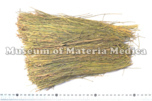Ephedra Herb

|
Market name:麻黄 Photo location:Museum of Materia Medica, Inst. of Nat. Med. TMPW No.:18571 |

|
Plant name:Ephedra sinica Photo location:Mongolia Photographer:K. Komatsu |
| Synonym | |
| Latin name | Ephedrae Herba |
| Botanical source: Family name | Ephedraceae |
| Botanical source: Plant name | - Ephedra sinica Stapf (IPNI:383460-1) - Ephedra intermedia Schrenk et C.A.Meyer (IPNI:383409-1) - Ephedra equisetina Bunge (IPNI:928049-1) |
| Part used | Dried green young branch |
| Empirical criteria for quality selection | Good one is fresh and green. (TN) |
| Constituents | Other aliphatic and related compounds: Nonacosan-10-ol, Nonacosan, Tricosan-1-ol Tannins: d-Catechin, l-Epicatechin, l-Gallocatechin, l-Epigallocatechin and their dimer and trimer Alkaloids: Ephedroxane Isoquinoline alkaloids: l-Ephedrine, d-Pseudoephedrine, l-Norephedrine, l-Nmethylephedrine, d-N-Methylpseudoephedrine, d-Norpseudoephedrine |
| Pharmacological effects | Antitussive, antiallergy (water, ethanol extract), excitation of sympathetic nerve(increase in blood pressure, bronchodilation, mydriasis, perspiration), central antitussive (ephedrine), antiinflammation(pseudoephedrine). |
| Indications | As a diaphoretic, antifebrile, antitussive and painkiller, it is applied to treat dyspnea due to disorder of skin excretion mechanism, stridor, asthma, chills, general aching and arthritis. |
| Diseases | Dyspnea, Cough, Chill, Fever, Anhidrosis, Headache, Somatic pain, Arthralgia, Common cold, Influenza, Bronchitis, Pneumonia, Bronchial asthma |
| Formulas | uzuto , uyakujunkisan , eppikajutsuto , eppikajutsubuto , eppikahangeto , eppito , kagaisan , kakkonkajutsubuto , kakkonkahangeto , kakkonto , kakkontokasenkyushin'i , kanzomaoto , kyososan , keikyososooshimbuto , keishieppito , keishishakuyakuchimoto , keishinieppiitto , keishinieppiittokajutsubu , keimakakuhanto , gokoto , goshakusan , saikatsugekito , saikatsutokasenkyushin'i , shoseiryuto , shoseiryutokakyoninsekko , shoseiryutokasekko , shozokumeito , shimpito , jingyokyokatsuto , zokumeito , daiseiryuto , dokkatsukakkonto , bofutsushosan , maokajutsuto , maoto , maobushikanzoto , maobushisaishinto , maorenshoshakushozuto , makyokansekito , makyoyokukanto , yakanmaoto , yokuininto , reitakutsukito , reitakutsukitokashin'i |
| Meridian tropism | Lung, Urinary bladder |
| Property | Warm |
| Flavor | Acrid/pungent, Slightly bitter |
| Classification in "Shen-non Ben-cao Jing" | Middle |
| TCM: Classification | Diaphoretics |
| TCM: Medicinal effects | To induce perspiration for dispelling cold, to relieve asthma and to cause diuresis. Used for common cold with wind-cold syndrome (marked by chilliness and mild fever, headache, stuffy and runny nose, general aching, but no sweating), edema in acute nephritis, bronchial asthma. |
| Remarks | Listed in the Japanese Pharmacopoeia 18th ed. |
| References | TN: T. Namba & Y. Tsuda ed., Outline of Pharmacognosy, a Textbook, 3rd ed., Nankodo Co., Ltd., Tokyo, 1998. |
DNA sequences of medicinal plants
| Gene Region | |||||||||||||||||||
| Nuclear | Chloroplast | Mitochondria | |||||||||||||||||
| Botanical source: Plant name | 5Ss | 18S | ITS1 | 5.8S | ITS2 | 26S | others | trnH-psbA | matK | trnK | trnK-rps16 | trnT-L | trnL | trnL-F | rbcL | rpoC1 | ndhF | others | |
|
|
|||||||||||||||||||
|
|
|||||||||||||||||||
|
|
|||||||||||||||||||
